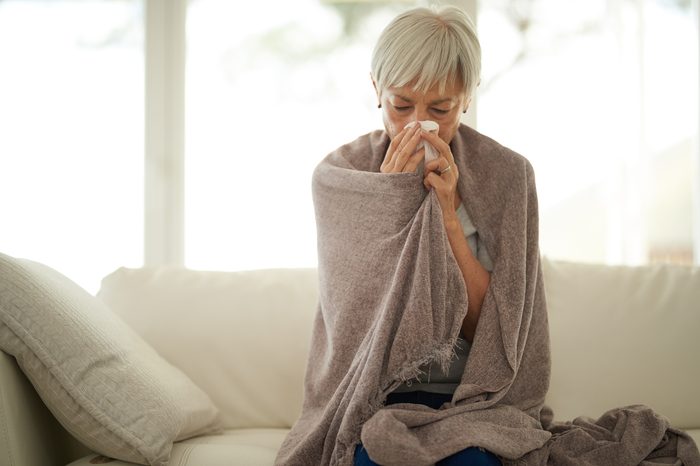
A global concern
Coronavirus has now infected over 120,000 people worldwide and a clearer picture of the constellation of symptoms caused by the virus—the infection is now called Covid-19—is starting to emerge. According to Health Canada, the public health risk associated with Covid-19 is low for Canadians, but this could change at any time. There is an increased risk for those over 65, who have a compromised immune system, and who have underlying health conditions.
Most of the cases—about 80 percent—are mild, says Robert Glatter, MD, an emergency physician with Lenox Hill Hospital in New York City. But the symptoms are also very “nonspecific,” adds Nestor Sosa, MD, chief of infectious diseases at the University of New Mexico School of Medicine in Albuquerque. That means they could easily be caused by other respiratory illnesses, like a cold or the flu.
The three most common symptoms seem to be fever, cough, and shortness of breath. Here’s more on each of those—plus other, less common symptoms.

Fever
The most common symptom of coronavirus by far seems to be a fever. The Centers for Disease Control and Prevention report says that 77 percent to 98 percent of people hospitalized with the virus have an elevated temperature. And another analysis reports that the fever is typically 100.4 degrees Fahrenheit or higher, sometimes with chills. One note: A fever may or may not be the first symptom reported. About 44 percent of more than 1,000 patients hospitalized with coronavirus in China had a fever when they first arrived at a healthcare facility, reports a study in the New England Journal of Medicine. That number rose to almost 89 percent after they were hospitalized. (Here’s what happens to your body when you have a fever.)

Cough
Health Canada says the second common symptom is a cough. It affects between 46 percent and 82 percent of patients in the hospital, according to the CDC. Although cough is a fairly widespread symptom, one distinguishing feature of this one is that it’s usually dry, says Dr. Sosa. The CDC believes that Covid-19 mostly spreads through respiratory droplets among people who are in close proximity to one another (within about six feet). That makes it imperative that people with symptoms cough (or sneeze) into a tissue or the crook of their arm, not their hands, advises the American Academy of Family Physicians (AAFP). (Find out if you should be wearing a face mask.)

Shortness of breath
This is a potentially troubling symptom which the CDC says affects between 3 percent and 31 percent of patients in the hospital. A study in the International Journal of Antimicrobial Agents (IJAA) puts the number at 34.5 percent, making it the third most common symptom. Shortness of breath can be scary. It can also escalate. The IJAA article reports that Covid-19 patients in the intensive care unit were more likely to have dyspnea than people who did not end up in the ICU. Respiratory symptoms are one of the main features of Covid-19, with many patients developing pneumonia and some even requiring oxygen therapy or mechanical ventilation. Fatigue has also been a common symptom, with the World Health Organization (WHO) estimating this affects 38.1 percent of patients.

Aches and pains
Also called myalgia, muscle aches and pains affected 13.9 percent of patients investigated by WHO. According to the Cleveland Clinic, it’s a common symptom of viral infections like colds and the flu although, says Dr. Glatter, flu symptoms typically come on more suddenly. Symptoms in mild cases of coronavirus infection (which is most cases) should subside on their own, says the AAFP. The association suggests calling your doctor if symptoms feel worse than a cold. Definitely phone first: Officials are asking that people always call their doctor or healthcare facility before showing up.

Headaches
Headaches have been reported in patients with Covid-19 affecting—according to WHO—about the same proportion of people as a sore throat, and both were relatively rare. There are, of course, many different types of headaches all with many possible causes, including stress. That said, if you have a headache along with symptoms like a fever, cough, and shortness of breath and have traveled recently or been in one of the areas of the United States with community transmission, call your doctor.

Diarrhea
Not many people with Covid-19 have reported diarrhea (only 3.7 percent by the WHO’s calculations) but it is notable in that it’s one of the few non-respiratory symptoms attached to the current outbreak. Coronaviruses in general can cause diarrhea in cows and pigs (infected chickens more often have respiratory disease), says the National Foundation for Infectious Diseases. The first confirmed case of coronavirus in the United States—in a 35-year-old man who had returned to Washington state from Wuhan, China—had loose bowel movements not long after being hospitalized. Stool samples did test positive for Covid-19, according to an article in the New England Journal of Medicine. Patients with SARS and MERS also reported gastrointestinal symptoms, according to one study.

Runny nose
Or, more accurately, lack of a runny nose and other nasal symptoms. Only 4 percent of patients in one sample reported this symptom but its absence may be notable in itself. “Covid-19 tends to be lower respiratory symptoms more than upper respiratory nasal symptoms,” says Dr. Sosa. Stanford Children’s Health is recommending that children who have congestion along with fever, cough, congestion, and nausea be tested for the flu. Those who have fever, cough, problems breathing and fatigue without a runny nose or nausea may be candidates for Covid-19 testing. Most of the Covid-19 cases in China were in adults, not children, says the CDC. Learn about other reasons your nose might be running.

No symptoms
According to a report issued by the World Health Organization (WHO), some cases of Covid-19 have been asymptomatic (patients didn’t have any symptoms), but most of these people did go on to develop symptoms later. A big concern is whether or not people with coronavirus but without symptoms can still spread the disease. The CDC reports that there have been asymptomatic transmissions, although the WHO states that this does not seem to be the main way the infection is spread. (Also, here’s what you need to know if you’re thinking about travelling during the Covid-19 outbreak.)

Treatment
There are no specific treatments for Covid-19, although scientists are looking at existing drugs to see if they can be useful. Some that have been tested so far include the HIV drugs (ritonavir and ASC09) and the antiviral remdesivir, originally developed to treat Ebola, according to an article in the journal Nature. Other than that, patients are receiving what’s known as “supportive care,” meaning fluids, pain relievers, anti-fever medications and, if needed, supplemental oxygen and mechanical ventilation. For people with mild symptoms who are staying at home, the AAFP recommends rest and plenty of fluids, then calling a healthcare professional if you’re having trouble breathing.
Next, learn about a nurse in Wuhan’s experience with the coronavirus and quarantine.
